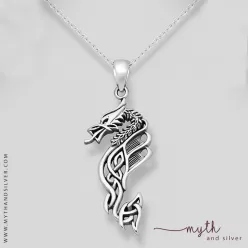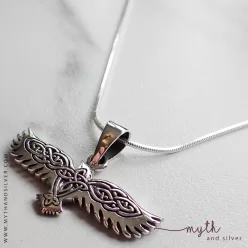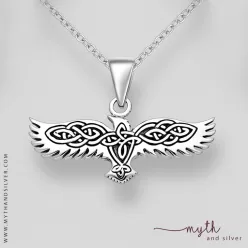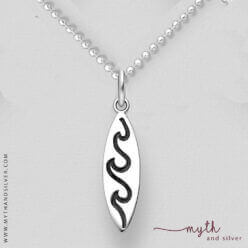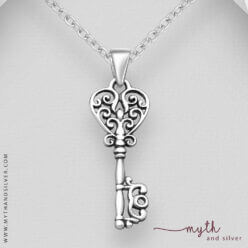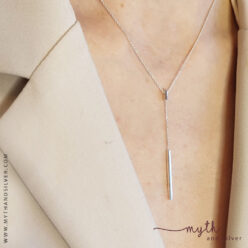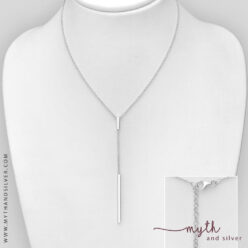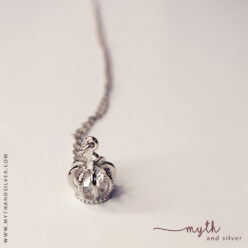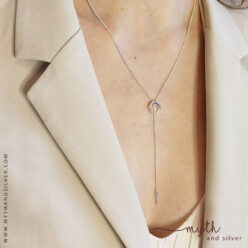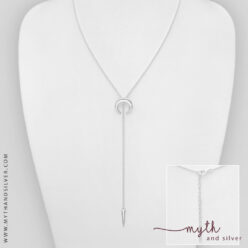About necklaces
Necklaces have been a prominent form of adornment for humans throughout history, serving as a symbol of beauty, status, spirituality, and cultural identity. From ancient civilizations to the Middle Ages, necklaces have played a significant role in human expression and personal style.
The origins of necklaces can be traced back to prehistoric times when early humans adorned themselves with shells, bones, feathers, and stones. These natural materials were fashioned into simple pendants and strung together with fibers or sinew, creating the earliest versions of necklaces. These primitive necklaces not only embellished the body but were also believed to possess protective and magical properties.
As civilizations flourished, necklaces became more refined and culturally specific. In ancient Egypt, necklaces held great significance and were often worn by both men and women. They were crafted from precious metals like gold and adorned with gemstones, such as lapis lazuli and turquoise. These necklaces not only served as a fashion statement but also had religious and spiritual connotations. The iconic collar necklace, known as the "usekh," was an integral part of Egyptian royal regalia, symbolizing wealth and power.
Moving eastward, in ancient Mesopotamia and Persia, necklaces were fashioned with intricate craftsmanship. Elaborate necklaces with intricate beadwork, pearls, and precious gemstones were worn by royalty and high-ranking individuals. These necklaces were often accompanied by amulets and talismans, believed to offer protection and ward off evil spirits.
The ancient Greeks also embraced necklaces as an essential accessory. They favored delicate and intricately designed necklaces made from gold, silver, and precious gemstones. The Greeks believed that necklaces had talismanic properties and would often wear pendants in the shape of animals, gods, and symbols. Additionally, the Greeks were known for their love of pearls, which were highly prized and associated with purity and wealth.
In ancient Rome, necklaces were a symbol of social status and were worn by both men and women. The Romans adopted various necklace styles from their conquered territories, including Egypt and Greece. Necklaces were often made from gold or silver and embellished with gemstones, pearls, and intricate metalwork. The elite classes would wear opulent necklaces as a display of their wealth and power.
During the Middle Ages, necklaces took on a religious significance, particularly in Christian Europe. Rosary necklaces became popular, serving as a tool for prayer and meditation. These necklaces featured beads made from precious materials and were often blessed by the Church. The wearing of crucifix necklaces also gained popularity, representing one's faith and devotion.
As the centuries progressed, necklaces continued to evolve, incorporating cultural influences and reflecting changing fashion trends. The Renaissance era saw a resurgence of intricate designs, incorporating enamel, cameos, and intricate metalwork. The Baroque period introduced grandiose necklaces with large gemstones and ornate embellishments, reflecting the opulence of the time.
Necklaces in modern times
In modern times, necklaces continue to be a popular accessory, albeit with evolving styles and meanings. While the traditional symbolism and cultural significance attached to necklaces still exist, the interpretation and personalization of necklaces have become more diverse and subjective.
Plain Chains: Plain chains remain a staple in modern necklace designs. They come in various metals, such as gold, silver, and stainless steel, and can be worn alone for a minimalistic look or layered with other necklaces for a trendy and personalized style. Plain chains are versatile and suitable for both casual and formal occasions. Note that all of our chains are Sterling Silver.
Pendants: Pendants are a popular choice for necklaces, allowing individuals to express their personal style and interests. Pendants can vary in shape, size, and materials used, ranging from classic designs like hearts and crosses to more unique and customized options, such as initials, symbols, or meaningful charms. Pendants can hold sentimental value, reminding wearers of loved ones, beliefs, or special memories.
Y Necklaces: Y necklaces feature a chain that splits into two strands, meeting at a single point with a pendant or charm. These necklaces create a visually appealing "Y" shape, elongating the neckline. Y necklaces can be worn with both casual and formal attire, adding an elegant touch to any outfit.
Beaded Necklaces: Beaded necklaces are popular for their vibrant and eclectic look. They can be made from a variety of materials, such as glass, wood, ceramic, or semi-precious stones. Beaded necklaces offer versatility, as they come in different lengths and styles, ranging from single-strand chokers to long, layered strands. Beaded necklaces allow individuals to experiment with colors, textures, and cultural influences.
Pearls: Pearls have long been associated with elegance and sophistication. In modern times, pearls continue to be a timeless choice for necklaces. Whether in classic strands, pendant designs, or incorporated with other gemstones, pearls symbolize grace and femininity. They are often worn for formal occasions, such as weddings and cocktail events. There are a wide range of pearls that vary in price (e.g. freshwater, cultured).
Pendants on Cords: Pendants on cords offer a casual and contemporary style. They typically feature a pendant or charm attached to a cord or leather string, creating a laid-back and bohemian look. These necklaces are popular among those seeking a more relaxed and effortless aesthetic.
Multi-Strand Necklaces: Multi-strand necklaces or layered necklaces add dimension and drama to an outfit. They consist of two or more strands of chains, beads, or pearls, often varying in length or style. Multi-strand necklaces can be worn with both casual and formal attire, making a statement and showcasing a bold sense of fashion.
Choker Necklaces: Choker necklaces are designed to fit closely around the neck, creating a stylish and contemporary look. They come in various materials, including velvet, leather, or metal, and can be adorned with pendants or charms. Chokers have gained popularity for their versatility, suitable for both casual and formal occasions.
Slider necklaces: feature a decorative element, often a pendant or charm, that slides along a smooth chain. The decorative elements on slider necklaces can vary widely, ranging from simple and minimalist designs to more elaborate and intricate motifs.
Lockets: Lockets offer wearers a personal and intimate way to carry cherished memories or symbols of significance. They serve as a reminder of loved ones, important milestones, or special moments. Lockets can be worn on their own as a statement piece or layered with other necklaces for a personalized and layered look.
In modern times, the meaning attached to necklaces varies from person to person. While some may still wear necklaces as a symbol of status, spirituality, or cultural identity, others may view them purely as a fashion accessory, a means of self-expression, or a way to commemorate special moments and relationships. The beauty of modern necklace wearing lies in its ability to adapt to individual preferences and styles, allowing people to curate their own narratives and showcase their unique personalities.

 SALE | 37% OFF!
SALE | 37% OFF! 
 SALE | 38% OFF!
SALE | 38% OFF! 
 SALE | 29% OFF!
SALE | 29% OFF! 
 SALE | 30% OFF!
SALE | 30% OFF! 

 SALE | 30% OFF!
SALE | 30% OFF! 

 SALE | 38% OFF!
SALE | 38% OFF! 
 SALE | 42% OFF!
SALE | 42% OFF! 
 SALE | 33% OFF!
SALE | 33% OFF! 
 SALE | 44% OFF!
SALE | 44% OFF! 
 SALE | 46% OFF!
SALE | 46% OFF! 
 SALE | 33% OFF!
SALE | 33% OFF! 
 SALE | 33% OFF!
SALE | 33% OFF! 
 SALE | 11% OFF!
SALE | 11% OFF! 


